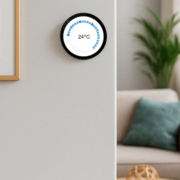Smart Panels for Hospital Patient Room Control
In the fast-evolving world of healthcare, the integration of technology has revolutionized the way patient care is delivered. Among the innovations that are making a significant impact are smart panels for hospital patient room control. These cutting-edge devices allow healthcare facilities to manage various aspects of a patient’s environment—such as lighting, temperature, entertainment, and communication—through a single, intuitive interface.
By providing a centralized platform for controlling room features, smart panels enhance the patient experience, improve operational efficiency, and support healthcare professionals in delivering higher quality care. Let’s take a closer look at the advantages and features of these smart panels, and how they are transforming hospital patient room management in 2025.
What Are Smart Panels for Hospital Patient Room Control?
A smart panel for hospital patient room control is an advanced touchscreen interface that enables healthcare staff and patients to control various aspects of a hospital room. These panels typically integrate with hospital systems to manage lighting, temperature, entertainment, and communication within the room.
Smart panels are designed to improve the comfort and convenience of patients while allowing healthcare staff to monitor and adjust settings remotely. These devices can be customized to meet the specific needs of the hospital, offering a high degree of control and flexibility.
Key Features of Smart Panels for Hospital Patient Room Control
1. Integrated Room Control System
One of the primary features of a smart panel for hospital patient room control is its ability to integrate and control multiple room functions. This can include:
- Lighting: Adjusting the lighting levels to create a more comfortable atmosphere for the patient.
- Temperature: Managing the room’s climate control, ensuring the patient is comfortable and at the desired temperature.
- Blinds/Curtains: Automating window coverings to allow patients to adjust privacy and control natural light.
This integration streamlines the patient room experience by centralizing control of various functions into a single, easy-to-use interface.
2. Entertainment and Communication Features
Modern smart panels offer entertainment options such as television, music, and internet access, allowing patients to remain engaged and distracted during their recovery process. By integrating these entertainment features into the smart panel, patients can easily control their favorite shows, movies, and even adjust the volume.
Additionally, smart panels often include communication features that allow patients to directly contact nursing staff or request assistance. Whether through a direct call to a nurse or a virtual assistant, these communication tools streamline patient requests and reduce response time.
3. Real-Time Monitoring and Alerts
For hospital staff, smart panels provide an effective means of real-time monitoring. Through integration with hospital systems such as patient monitoring devices and bed alarms, these panels can notify staff of critical changes in a patient’s condition. Whether it’s a drop in heart rate, blood pressure, or another urgent situation, the smart panel provides immediate alerts, enabling quicker responses and better patient outcomes.
4. Customizable Interfaces
Each hospital patient room may have different needs depending on the patient’s condition, age, or personal preferences. A smart panel offers a customizable interface that can be tailored to the specific requirements of individual patients. Whether it’s a simple interface for elderly patients or more advanced controls for patients with specific medical needs, these panels can be adapted to offer the right level of control and ease of use.
5. Energy Management
In addition to improving patient comfort, smart panels can also play a significant role in energy management. By automating lighting, temperature, and other room features based on occupancy or preset schedules, hospitals can optimize energy usage, reduce operational costs, and contribute to sustainability goals.
Benefits of Smart Panels for Hospital Patient Room Control
1. Improved Patient Experience
A smart panel enhances the patient experience by providing an intuitive, user-friendly interface that allows them to easily control various aspects of their environment. Patients can adjust the room temperature, lighting, or entertainment system without needing to call for assistance, which promotes a sense of independence and comfort. This is especially important in promoting positive outcomes and improving the overall hospital experience.
2. Increased Operational Efficiency
For hospital staff, smart panels improve operational efficiency by centralizing room control. Staff no longer need to manually adjust each room’s temperature, lighting, or blinds—this can all be done from one location, saving valuable time. In addition, real-time alerts allow staff to stay on top of patient needs, reducing response times and improving the workflow.
3. Enhanced Communication
With integrated communication tools, smart panels help enhance communication between patients and healthcare providers. Patients can easily request assistance, while nurses and doctors can use the system to communicate important updates. This ensures that patients receive timely care and improves overall hospital efficiency.
4. Data-Driven Insights
Smart panels can be connected to hospital data systems, providing valuable insights into room usage, energy consumption, and patient preferences. These data-driven insights help hospital administrators make more informed decisions about room management and resource allocation, leading to cost savings and better patient care.
5. Increased Hygiene and Infection Control
By reducing the need for patients to press physical buttons or handle manual controls, smart panels also help minimize cross-contamination and enhance infection control in patient rooms. The touchless functionality and remote control features reduce the risk of spreading germs and bacteria, which is especially important in healthcare settings.
Applications in Various Hospital Settings
- Patient Rooms: The most common application of smart panels is in hospital patient rooms, where they enhance comfort, streamline control, and improve communication.
- Nurse Stations: Smart panels can also be used at nurse stations for centralized control of patient rooms, allowing healthcare providers to monitor and adjust patient environments without needing to visit each room individually.
- ICU and Emergency Rooms: In more critical care environments like ICUs and emergency rooms, smart panels provide real-time monitoring and alerts that help ensure quick intervention when required.
- Long-Term Care Facilities: In long-term care or rehabilitation facilities, smart panels can help patients maintain control over their environment while providing important data to caregivers.
Smart panels for hospital patient room control are rapidly transforming how healthcare providers manage patient care, and they hold immense potential for improving both patient outcomes and operational efficiency. By centralizing room control, integrating communication and entertainment systems, and enabling real-time monitoring, these panels create a more comfortable, efficient, and secure environment for both patients and staff.


